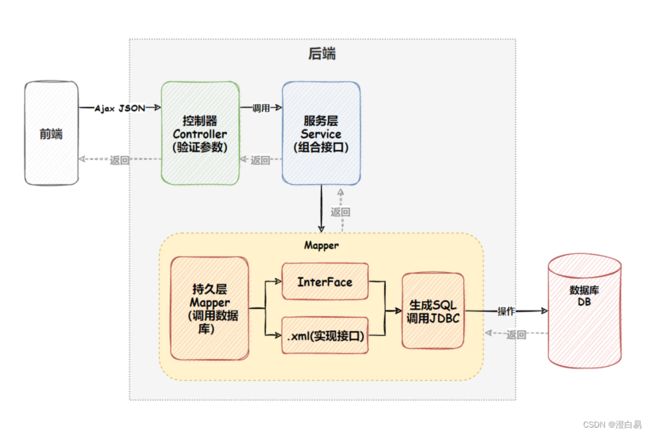MyBatis 查询数据库
目录
- 1.什么是 MyBatis
- 2.MyBatis 环境搭建
-
- 2.1 创建数据库和表
- 2.2 添加 MyBatis 框架支持
- 2.3 配置数据库连接和MyBatis
- 2.4 添加代码
-
- 2.4.1 添加实体类
- 2.4.2 添加 mapper 接口
- 2.4.3 添加 UserMapper.xml
- 2.4.4 添加 Service
- 2.4.5 添加 Controller
- 3.MyBatis 增删改查操作
-
- 3.1 增加操作
- 3.2 删除操作
- 3.3 修改操作
- 3.4 查询操作
-
- 3.4.1 单表查询
- 3.4.2 多表查询
- 3.4.3 like查询
- 4.动态SQL使用
-
- 4.1 if 标签
- 4.2 trim 标签
- 4.3 where 标签
- 4.4 set 标签
- 4.5 foreach 标签
1.什么是 MyBatis
MyBatis是一款优秀的持久层框架,它支持 自定义 SQL、存储过程 以及 高级映射 。MyBatis去除了几乎所有的 JDBC 代码以及设置参数和获取结果集的工作。MyBatis可以通过简单的 XML 或 注解 来配置和映射原始类型、接口和 Java POJO(Plain Old Java Objects,普通老式 Java 对象)为数据库中的记录。
简单来说 MyBatis 是更简单完成程序和数据库交互的工具,也就是更简单的操作和读取数据库工具。
2.MyBatis 环境搭建
开始搭建 MyBatis 之前,MyBatis 在整个框架中的定位,框架交互流程图:

MyBatis 也是一个 ORM 框架,ORM(Object Relational Mapping),即对象关系映射。在面向对象编程语言中,将关系型数据库中的数据与对象建立起映射关系,进而自动的完成数据与对象的互相转换:
- 将输入数据(即传入对象)+SQL 映射成原生 SQL
- 将结果集映射为返回对象,即输出对象
ORM 把数据库映射为对象:
- 数据库表(table)–> 类(class)
- 记录(record,行数据)–> 对象(object)
- 字段(field) --> 对象的属性(attribute)
一般的 ORM 框架,会将数据库模型的每张表都映射为一个 Java 类。 也就是说使用 MyBatis 可以像操作对象一样来操作数据库中的表,可以实现对象和数据库表之间的转换。
2.1 创建数据库和表
-- 创建数据库
drop database if exists mycnblog;
create database mycnblog DEFAULT CHARACTER SET utf8mb4;
-- 使用数据数据
use mycnblog;
-- 创建表[用户表]
drop table if exists userinfo;
create table userinfo(
id int primary key auto_increment,
username varchar(100) not null,
password varchar(32) not null,
photo varchar(500) default '',
createtime datetime default now(),
updatetime datetime default now(),
`state` int default 1
) default charset 'utf8mb4';
-- 创建文章表
drop table if exists articleinfo;
create table articleinfo(
id int primary key auto_increment,
title varchar(100) not null,
content text not null,
createtime datetime default now(),
updatetime datetime default now(),
uid int not null,
rcount int not null default 1,
`state` int default 1
)default charset 'utf8mb4';
-- 创建视频表
drop table if exists videoinfo;
create table videoinfo(
vid int primary key,
`title` varchar(250),
`url` varchar(1000),
createtime datetime default now(),
updatetime datetime default now(),
uid int
)default charset 'utf8mb4';
2.2 添加 MyBatis 框架支持
① 在已有的项目中添加:
<dependency>
<groupId>org.mybatis.spring.bootgroupId>
<artifactId>mybatis-spring-boot-starterartifactId>
<version>2.1.4version>
dependency>
<dependency>
<groupId>mysqlgroupId>
<artifactId>mysql-connector-javaartifactId>
<scope>runtimescope>
dependency>
② 在创建新项目时添加:
2.3 配置数据库连接和MyBatis
在 application.yml 配置数据库连接:
# 配置数据库连接
spring:
datasource:
url: jdbc:mysql://127.0.0.1/mycnblog?charsetEncoding=utf8
username: root
password: 12345678
driver-class-name: com.mysql.cj.jdbc.Driver
配置 MyBatis 中的 XML 路径:
# 设置Mybatis的xml保存路径
mybatis:
mapper-locations: classpath:mybatis/**Mapper.xml
2.4 添加代码
按照后端开发的工程思路来实现 MyBatis 查询所有用户的功能:

目录结构:

2.4.1 添加实体类
添加用户的实体类:
@Setter
@Getter
@ToString
public class UserInfo {
private int id;
private String username;
private String password;
private String photo;
private String createtime;
private String updatetime;
private int state;
}
2.4.2 添加 mapper 接口
数据持久层的接口定义:
@Mapper
public interface UserMapper {
public List<UserInfo> getAll();
}
2.4.3 添加 UserMapper.xml
数据持久层的实现,mybatis 的固定 xml 格式:
DOCTYPE mapper PUBLIC "-//mybatis.org//DTD Mapper 3.0//EN"
"http://mybatis.org/dtd/mybatis-3-mapper.dtd">
<mapper namespace="com.example.demo.mapper.UserMapper">
mapper>
UserMapper.xml 查询所有用户的具体实现 SQL:
DOCTYPE mapper PUBLIC "-//mybatis.org//DTD Mapper 3.0//EN"
"http://mybatis.org/dtd/mybatis-3-mapper.dtd">
<mapper namespace="com.example.demo.mapper.UserMapper">
<select id="getAll" resultType="com.example.demo.model.UserInfo">
select * from userinfo
select>
mapper>
标签说明:
-
-
查询标签:是用来执行数据库的查询操作的:id:是和 Interface(接口)中定义的方法名称一样的,表示对接口的具体实现方法。
resultType:是返回的数据类型,也就是开头我们定义的实体类。
2.4.4 添加 Service
服务层实现代码如下:
@Service
public class UserService {
@Resource
private UserMapper userMapper;
public List<UserInfo> getAll() {
return userMapper.getAll();
}
}
2.4.5 添加 Controller
控制器层的实现代码如下:
@RestController
@RequestMapping("/user")
public class UserController {
@Resource
private UserService userService;
@RequestMapping("/getuserbyid")
public UserInfo getUserById(Integer id) {
if (id != null && id > 0) {
return userService.getUserById(id);
} else {
return new UserInfo();
}
}
}
3.MyBatis 增删改查操作
操作步骤:
- 添加 controller
- 添加 service
- 添加 mapper (dao)
- 添加 xml
3.1 增加操作
① 添加 controller:
@RequestMapping("/insert")
public Integer insert(UserInfo userInfo) {
return userService.insert(userInfo);
}
② 添加 service:
public Integer insert(UserInfo userInfo) {
return userMapper.insert(userInfo);
}
③ 添加 mapper :
Integer insert(UserInfo userInfo);
④ 添加 xml:
<insert id="add">
insert into userinfo(username,password,photo,state)
values(#{username},#{password},#{photo},1)
insert>
说明:参数占位符 #{} 和 ${}
#{}:预编译处理。${}:字符直接替换。
预编译处理是指:MyBatis 在处理#{}时,会将 SQL 中的 #{} 替换为 ? 号,使用用PreparedStatement 的set 方法来赋值。直接替换:是MyBatis 在处理 ${} 时,就是把 ${} 替换成 变量的值。
特殊的增加
默认情况下返回的是受影响的行号,如果想要返回自增 id,具体实现如下:
controller 实现代码:
public Integer add2(@RequestBody UserInfo userInfo) {
userService.getAdd2(userInfo);
return user.getId();
}
mapper 接口:
@Mapper
public interface UserMapper {
// 添加,返回⾃增id
void add2(User user);
}
mapper.xml 实现如下:
<insert id="add2" useGeneratedKeys="true" keyProperty="id">
insert into userinfo(username,password,photo,state)
values(#{username},#{password},#{photo},1)
insert>
useGeneratedKeys:这会令 MyBatis 使用 JDBC 的 getGeneratedKeys 方法来取出由数据库内部生成的主键(比如:像 MySQL 和 SQL Server 这样的关系型数据库管理系统的自动递增字段),默认值:false。keyColumn:设置生成键值在表中的列名,在某些数据库(像 PostgreSQL)中,当主键列不是表中的第一列的时候,是必须设置的。如果生成列不止一个,可以用逗号分隔多个属性名称。keyProperty:指定能够唯一识别对象的属性,MyBatis 会使用 getGeneratedKeys 的返回值或 insert 语句的 selectKey 子元素设置它的值,默认值:未设置(unset)。如果生成列不止一个,可以用逗号分隔多个属性名称。
3.2 删除操作
前面三个步骤操作类似,重点看下第四步,数据持久层的实现(xml)。
<delete id="delById" parameterType="java.lang.Integer">
delete from userinfo where id=#{id}
delete>
3.3 修改操作
<update id="update">
update userinfo set username=#{name} where id=#{id}
update>
3.4 查询操作
3.4.1 单表查询
查询操作需要设置返回类型,绝大数查询场景可以使用 resultType 进行返回,它的优点是使用方便,直接定义到某个实体类即可。
<select id="getUserById" resultType="com.example.demo.model.UserInfo">
select *
from userinfo
where id = #{id}
select>
3.4.2 多表查询
但有些场景就需要用到返回字典映射(resultMap)比如:
- 字段名称和程序中的属性名不同的情况;
- ⼀对⼀和⼀对多关系。
① 字段名和属性名不同的情况
<resultMap id="BaseMap" type="com.example.demo.model.UserInfo">
<id column="id" property="id">id>
<result column="username" property="username">result>
<result column="password" property="pwd">result>
resultMap>
<select id="getUserById"
resultMap="com.example.demo.mapper.UserMapper.BaseMap">
select * from userinfo where id=#{id}
select>

② 一对一映射
一对一映射要使用
<resultMap id="BaseMap" type="com.example.demo.model.ArticleInfo">
<id property="id" column="id">id>
<result property="title" column="title">result>
<result property="content" column="content">result>
<result property="createtime" column="createtime">result>
<result property="updatetime" column="updatetime">result>
<result property="uid" column="uid">result>
<result property="rcount" column="rcount">result>
<result property="state" column="state">result>
<association property="user"
resultMap="com.example.demo.mapper.UserMapper.BaseMap"
columnPrefix="u_">
association>
resultMap>
<select id="getAll" resultMap="BaseMap">
select a.*,u.username u_username from articleinfo a
left join userinfo u on a.uid=u.id
select>
property属性:指定 Article 中对应的属性,即用户。resultMap属性:指定关联的结果集映射,将基于该映射配置来组织用户数据。columnPrefix属性:绑定一对一对象时,是通过
columnPrefix+association.resultMap.column 来映射结果集字段。
③ 一对多映射
一对多需要使用
<resultMap id="BaseMap" type="com.example.demo.model.UserInfo">
<id column="id" property="id" />
<result column="username" property="username">result>
<result column="password" property="password">result>
<result column="photo" property="photo">result>
<collection property="alist"
resultMap="com.example.demo.mapper.ArticleInfoMapper.BaseMap"
columnPrefix="a_">
collection>
resultMap>
<select id="getUserById" resultMap="BaseMap">
select u.*,a.title a_title from userinfo u
left join articleinfo a on u.id=a.uid where u.id=#{id}
select>
3.4.3 like查询
like 使用 #{} 会报错,可以考虑使用 mysql 的内置函数 concat() 来处理,实现代码如下:
<select id="getUserByLikeName" resultType="com.example.demo.model.UserInfo">
select *
from userinfo
where username like concat('%', #{username}, '%')
select>
4.动态SQL使用
动态 sql 是Mybatis的强大特性之一,能够完成不同条件下不同的 sql 拼接。
可以参考官方文档:Mybatis动态sql
4.1 if 标签
<insert id="add3">
insert into userinfo(username,
<if test="photo!=null">
photo,
if>
password)
values (#{username},
<if test="photo!=null">
#{photo},
if>
#{password})
insert>
test中的对象是传入对象的属性,当它不为空时,才拼接里面的内容。
4.2 trim 标签
prefix:表示整个语句块,以prefix的值作为前缀suffix:表示整个语句块,以suffix的值作为后缀prefixOverrides:表示整个语句块要去除掉的前缀suffixOverrides:表示整个语句块要去除掉的后缀
示例:
<insert id="add4">
insert into userinfo
<trim prefix="(" suffix=")" suffixOverrides=",">
<if test="username!=null">
username,
if>
<if test="photo!=null">
photo,
if>
<if test="password!=null">
password
if>
trim>
values
<trim prefix="(" suffix=")" suffixOverrides=",">
<if test="username!=null">
#{username},
if>
<if test="photo!=null">
#{photo},
if>
<if test="password!=null">
#{password}
if>
trim>
insert>
4.3 where 标签
传入的用户对象,根据属性做where条件查询,用户对象中属性不为 null 的,都为查询条件。
标签, 如果有查询条件就会生成where, 如果没有查询条件就不会生成where会判断第一个条件前面有没有and, 如果有就会去掉.
<select id="getList" resultMap="BaseMap">
select * from userinfo
<where>
<if test="username!=null">
username=#{username}
if>
<if test="password!=null">
and password=#{password}
if>
where>
select>
4.4 set 标签
更新的时候也会出现问题, 使用
<update id="updateById">
update userinfo
<set>
<if test="username!=null">
username=#{username},
if>
<if test="password!=null">
password=#{password}
if>
set>
where id=#{id}
update>
4.5 foreach 标签
对集合进行遍历时可以使用该标签。标签有如下属性:
collection:绑定方法参数中的集合,如 List,Set,Map或数组对象item:遍历时的每一个对象open:语句块开头的字符串close:语句块结束的字符串separator:每次遍历之间间隔的字符串
示例:
<delete id="delete">
delete from userinfo where id in
<foreach collection="list" item="id" open="(" close=")" separator=",">
#{id}
foreach>
delete>


